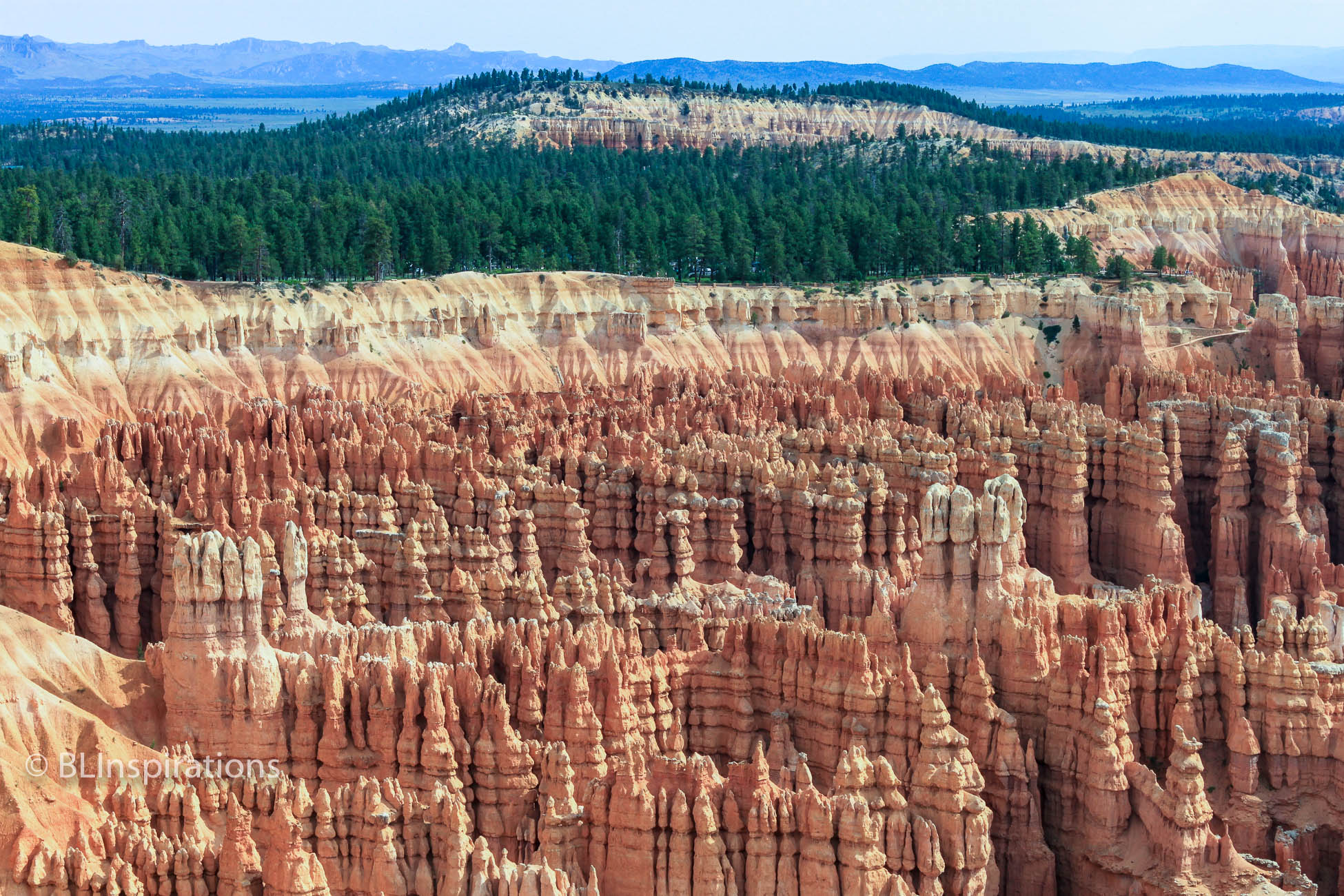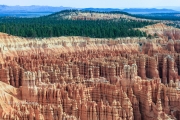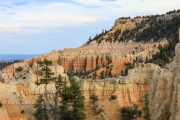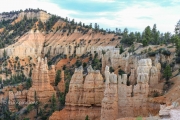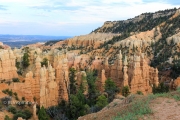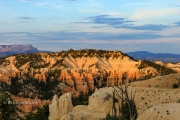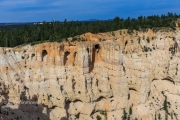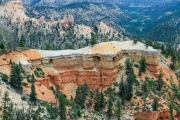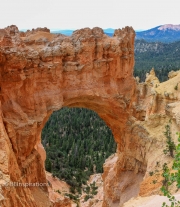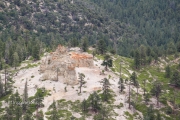By Laurie
Note: This post is one of a series about my 2015 Western Parks vacation with my daughter and grandson. For our itinerary with links to other posts and an overview of this trip, please see 2015 Western Parks Vacation.
After a morning horseback ride, we arrived at Bryce Canyon National Park in southern Utah on the evening of Friday July 3 and left the morning of Sunday July 5.
Bryce Canyon National Park is noted for its “hoodoos”, which are irregularly shaped columns of rock. Hoodoos exist around the world, but by far the largest concentration is found in Bryce Canyon. We had experienced different emotional responses to the parks we visited but the hoodoos in Bryce Canyon are uniquely beautiful. My daughter was so impacted by their beauty that she was in tears.
While we were at Bryce Canyon, we attended a talk given by a German geologist who spends every summer at Bryce, studying the geology and giving talks. He explained how hoodoos are formed and the unique properties of Bryce Canyon (location, elevation, climate) that contribute to their formation.
When looking out from the many vistas and overlooks at Bryce, in addition to the hoodoos, the many different colored layers of rock are also immediately noticeable. The rock colors are mostly white, orange, tan, pink, and red and reflect the history of millions of years of deposition of particles from erosion of higher elevations into what was once a low lying area. The rock layers at Bryce consist of limestone, dolostone, mudstone, siltstone, and sandstone. Later, the entire Colorado Plateau, including the Bryce Canyon area, was elevated by Plate Tectonics as the Farallon Plate was forced underneath the North American Plate. As a result, the Bryce Canyon area is at the perfect elevation for the creation of Bryce’s hoodoos.
Formation of Hoodoos
The uplift of the Colorado Plateau created vertical cracks which were eroded over time. Starting from a plateau, the rock eventually breaks down into walls or fins, then windows, and then into individual hoodoos. This progression has taken about 10 million years and is described in the links in the Additional Information section below and illustrated in some of the photos in the Additional Images gallery below.
Weathering is the breaking down of rock by weather, and erosion is the movement of the broken rock pieces. These two forces work together to create Bryce Canyon’s hoodoos. Ice, rain and temperature variations are the natural forces of weathering and erosion that create the hoodoos.
In Bryce the soft under layers of rock are covered by a layer of hard rock, such as well-cemented sandstone, limestone, or basalt. Hoodoos are tall skinny shafts of rock that protrude from the bottom of the arid basin and they form where a small cap of the resistant layer remains, protecting the underlying softer layers from erosion. In Bryce Canyon, the hoodoos range in height from that of an adult human to that of a 10-story building. The difference between hoodoos and spires is that hoodoos have a variable thickness and are often described as having a “totem pole-shaped body” while spires have a smoother profile with a more uniform thickness that tapers from the ground upward.
Bryce Canyon experiences more than 200 freeze/thaw cycles each year. That means on more than half of the days of the year, Bryce Canyon has temperatures that are both above and below freezing in the same 24 hour period. This temperature variation is crucial to the formation of hoodoos.
Water (from either rain or snow that has melted) seeps into cracks in the rock. Later, when freezing temperatures occur, the water trapped inside the rock freezes into ice (when water freezes, it expands by 9%). This expansion causes tremendous pressure on the surrounding rock, causing it to break apart, similar to the way a pothole forms in a paved road. This process is known as “ice wedging”, because the ice is literally wedging apart pieces of the rocks. These pieces range in size from small pebbles to car-sized boulders, which break up into smaller pieces when they hit the ground. However, the same processes that create hoodoos will eventually destroy them. In Bryce Canyon, the rate of erosion of the hoodoos is about 2–4 feet every 100 years.
When looking at a hoodoo, some rock layers project out, while others are recessed. These differences are related to slight variations in the material which make up the different rock layers. As mentioned above, there are multiple types of rock that make up Bryce Canyon’s formations and all of them contain calcium carbonate (CaCO3), a mineral which dissolves when it comes into contact with even slightly acidic water. When it rains at Bryce Canyon, the (slightly) acidic rain dissolves small amounts of calcium carbonate and allows the rock layers to erode into their unusual shapes. These shapes are a result of the rock layers having different amounts of calcium carbonate, which controls how easily dissolvable (or how resistant) that rock layer is.
Additional Images
Additional Information
DesertUSA – Hoodoos Of Bryce Canyon
National Park Service – Bryce Canyon – Hoodoos
Utah National Park Trips – What are Hoodoos?
Wikipedia – Geology of the Bryce Canyon area
Wikipedia – Hoodoo (Geology)
Technical Data
Bryce Canyon Hoodoos
- Date:7/4/2015
- Time: 9:54 AM
- Camera: Canon EOS Rebel T1i
- Lens: Canon EF-S 18-55 mm f/3.5-5.6 IS
- Settings:
- Lens: 49 mm, f/11
- ISO: 100
- Shutter: 1/160 sec
- Uncropped image is 4752 x 3168 px
Fairyland Canyon Colored Rock Layers
- Date:7/3/2015
- Time: 8:26 PM
- Camera: Canon EOS Rebel T1i
- Lens: Canon EF-S 55-250 mm f/4-5.6 IS
- Settings:
- Lens: 55 mm, f/5.6
- ISO: 125
- Shutter: 1/50 sec
- Uncropped image is 4752 x 3168 px
Fairyland Canyon Colors
- Date:7/3/2015
- Time: 8:19 PM
- Camera: Canon EOS Rebel T1i
- Lens: Canon EF-S 18-55 mm f/3.5-5.6 IS
- Settings:
- Lens: 28 mm, f/5.6
- ISO: 125
- Shutter: 1/30 sec
- Uncropped image is 4752 x 3168 px
Fairyland Canyon Hoodoos 2
- Date:7/3/2015
- Time: 8:22 PM
- Camera: Canon EOS Rebel T1i
- Lens: Canon EF-S 18-55 mm f/3.5-5.6 IS
- Settings:
- Lens: 21 mm, f/5.6
- ISO: 100
- Shutter: 1/30 sec
- Uncropped image is 4752 x 3168 px
Bryce Point Panorama
- Date:7/4/2015
- Time: 9:28 AM
- Camera: Canon EOS Rebel T1i
- Lens: Canon EF-S 18-55 mm f/3.5-5.6 IS
- Settings:
- Lens: 20 mm, f/13
- ISO: 100
- Shutter: 1/160 sec
- Cropped image is 9660 x 4662 px
Bryce Point Hoodoo Creation
- Date:7/4/2015
- Time: 9:25 AM
- Camera: Canon EOS Rebel T1i
- Lens: Canon EF-S 18-55 mm f/3.5-5.6 IS
- Settings:
- Lens: 24 mm, f/14
- ISO: 100
- Shutter: 1/160 sec
- Cropped image is 4113 x 2742 px
Bryce Canyon Natural Bridge Panorama
- Date:7/4/2015
- Time: 12:52 PM
- Camera: Canon EOS Rebel T1i
- Lens: Canon EF-S 18-55 mm f/3.5-5.6 IS
- Settings:
- Lens: 32 mm, f/10
- ISO: 100
- Shutter: 1/80 sec
- Cropped image is 4630 x 5321 px
Inspiration Point Panorama 2
- Date:7/4/2015
- Time:10:03 AM
- Camera: Canon EOS Rebel T1i
- Lens: Canon EF-S 55-250 mm f/4-5.6 IS
- Settings:
- Lens: 55 mm, f/5
- ISO: 100
- Shutter: 1/640 sec
- Cropped image is 5743 x 11639 px
“New” Hoodoos in Fairyland Canyon
- Date:7/3/2015
- Time: 8:27 PM
- Camera: Canon EOS Rebel T1i
- Lens: Canon EF-S 18-55 mm f/3.5-5.6 IS
- Settings:
- Lens: 55 mm, f/5.6
- ISO: 320
- Shutter: 1/60 sec
- Cropped image is 2494 x 3741 px
Fairyland Canyon Hoodoos 1
- Date:7/3/2015
- Time: 8:21 PM
- Camera: Canon EOS Rebel T1i
- Lens: Canon EF-S 18-55 mm f/3.5-5.6 IS
- Settings:
- Lens: 28 mm, f/5.6
- ISO: 100
- Shutter: 1/30 sec
- Uncropped image is 4752 x 3168 px
Fairyland Canyon Hoodoos 1
- Date:7/3/2015
- Time: 8:26 PM
- Camera: Canon EOS Rebel T1i
- Lens: Canon EF-S 18-55 mm f/3.5-5.6 IS
- Settings:
- Lens: 42 mm, f/6.3
- ISO: 100
- Shutter: 1/60 sec
- Uncropped image is 4752 x 3168 px
Bryce Point Hoodoos
- Date:7/4/2015
- Time: 9:33 AM
- Camera: Canon EOS Rebel T1i
- Lens: Canon EF-S 18-55 mm f/3.5-5.6 IS
- Settings:
- Lens: 28 mm, f/11
- ISO: 100
- Shutter: 1/125 sec
- Uncropped image is 4752 x 3168 px
Fin with Cap Rock and Windows
- Date:7/4/2015
- Time: 12:32 PM
- Camera: Canon EOS Rebel T1i
- Lens: Canon EF-S 18-55 mm f/3.5-5.6 IS
- Settings:
- Lens: 55 mm, f/10
- ISO: 100
- Shutter: 1/200 sec
- Uncropped image is 4752 x 3168 px
Worn down formation in Ponderosa Canyon
- Date:7/4/2015
- Time: 1:10 PM
- Camera: Canon EOS Rebel T1i
- Lens: Canon EF-S 55-250 mm f/4-5.6 IS
- Settings:
- Lens: 146 mm, f/5.6
- ISO: 320
- Shutter: 1/1250 sec
- Cropped image is 4118 x 2745 px
